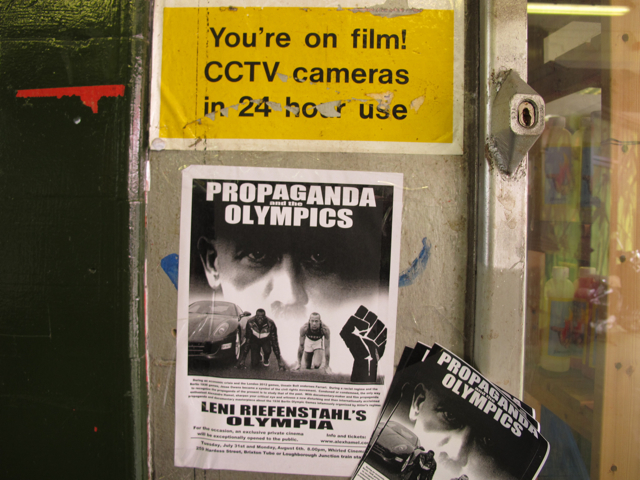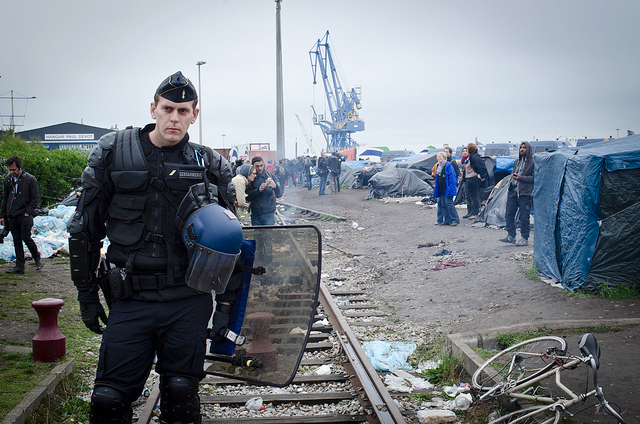“Sport has established itself as the spearhead of an army in battle order, which crushes anyone who is stupefied by it,” writes Marc Perelman in Barbaric Sport: A Global Plague. Fittingly, for a project rooted in Adorno and the France of May 1968, Perelman’s concern is with sports as a mass phenomenon, one he locates at the core of capitalist society.
The quote above caps off an impressive rant, in which he first laments the ways everyday life is “contaminated, consumed, infected” by the “insidious infiltration” of sport, then connects this infiltration to totalitarian regimes such as those in Germany and the Soviet Union (when they held the Olympics) and Argentina (when they hosted the World Cup,) stating that sport was “not an annexe to the internal political situation but, on the contrary, playing a fundamental role in the advent and consolidation of the regimes.” Perelman’s self-chosen position as an outsider does give him a unique and useful perspective on Sport.
Hardcore sports fans might struggle to separate themselves from their passion long enough to make a critique. Certainly, it’s easier for us to apply a “ruthless criticism of everything existing” when the target is something that hasn’t already sucked us into its vortex. Part of the value of Perelman’s attack on Sport is that he has no such struggle.
From his perspective, while the masses are content to consume Sport, this separation from them allows him to see Sport for what it “really” is. The masses are too invested in Sport. Writing about the Chinese peasants who helped build Olympic stadia, he notes that they “lack awareness of the vast movement of historical change that carries them forward.” But it isn’t just Chinese peasants who have this problem where Sport is concerned. In a way, Perelman suggests, it’s hard not to act like a “Chinese peasant” when confronted with a mass phenomenon of such unprecedented scope. There simply isn’t much room left for an outsider’s position.
Perelman suggests that those who might have adopted a critical stance were gradually pushed aside by “the irresistible power of a mass phenomenon that has no equal today.” But this does not hold him back. He argues passionately for the importance of critical analysis, especially in the case of something as integrated into global daily life as Sport. And he clearly takes pride in his vigilance in resisting that “irresistible power.”
Barbaric Sport is particularly good on the “Olympic ideal”. (This is obviously timely, and in fact, a new English translation has been released just in time for the London Olympics.) The ideal, he points out, has little to do with reality. In the name of a supposedly apolitical celebration of Sport, the Olympics exist as an enormous capitalist enterprise. And whatever ideals might appear in the Olympic Charter, there is always room for a Berlin in 1936 or a Beijing in 2008. The world pays attention only to the games, while the corrupt governments consolidate and expand their power.
Perelman’s anger is inspired, although he may exaggerate the secrecy with which the Olympics operate. It seems pretty clear that many fans know that the Olympics are a capitalist event designed to make a lot of money. Perelman may be correct that the masses don’t care about the money, but he’s not exactly telling us things we don’t already know. This hints at a fundamental problem with Perelman’s approach. His opinion of the masses is old school: they have been “stupefied” to the point where they are just plain stupid.
The book offers up page after page on the negative effects of mass culture on society. He rarely speaks of individuals within the mass. “When the mass sings, chants, vibrates, when it asserts its own rhythm by bawling deafening slogans, stamping its feet or performing ill-coordinated ‘waves’, it is only accentuating its character as a pure agitated surface. … following some exploit on the field, a roar arises ‘spontaneously’ from the mass. It is these roars, whatever their cause, that express the mass and give it its psychic space, but they also demolish any conscious, aware focus on the world.”
Bawling and stamping, ill-coordinated, agitated, lacking the ability to focus on “the world”: Perelman seems terrified by “the mass”. And the all-encompassing power of his understanding of the masses allows for no individual awareness. Nowhere in Barbaric Sport is there any sense of the myriad ways fans can have a personal relationship to sport, even as they participate in a mass function. It’s as if no one ever pointed out to Perelman that mass culture is not always or only top-down, that people can personalize their experience with mass culture in ways the originator may not have intended. While critical distance is important, there is an elitist tone in his condemnation of the masses that saturates all of the book. He elevates his distant self, and acts like only he can see the truth, while the masses merely celebrate.
It gets worse when Perelman moves on to youth. He offers paeans to the young of the past, which at first seems encouraging, describing them as a “‘natural’ opposition force” who “were constantly instrumentalized by movements like the anti-racist movement SOS-Racisme.” But now? “The present goals of the young, their wishes, their life plans, are developing in a conformist register, in an environment of consent to the mainstream values of society, and much less in a critical spirit towards it.”

Ah, the kids these days. So disappointing. Perelman might as well tell them to get off of his lawn. And, of course, there’s all that modern technological foofaraw, taking us away from the “natural.” His disappointment is tangible: “From being a force of radical opposition to society, the youth has more or less capitulated to forms of mass-market navel-gazing: it has split off into Gay Pride marches and other macro-enterprises, or brain-rotting new technologies (iPods, MP3s, smartphones etc.); it has become depoliticized to the point of apathy or surrender to the innumerable screens foisted on it, to which it glues itself without a thought for critical distance.”
Perelman presents no empirical evidence to support his claims, though he does quote Theodor Adorno, Walter Benjamin, Siegfried Kracauer and other cultural theorists. (Ironically, at one point he refers to “my conviction, based on research rather than simple opinion,” even though the book is full of opinion and notably lacking in factual research.) Once he feels he has established the mainstream capitulation of youth, he easily assigns blame to Sport: “Its own idols and icons … are often involved in providing sporting spectacle and sport has thus become youth’s natural décor and backdrop.”
The Puritanistic strain suggested by terms such as “brain-rotting” and “navel-gazing” exists throughout the book, nowhere more so than in Perelman’s discussion of the Dieux du Stade, or Gods of the Stadium, a regular series of calendars, books, and DVDs from France featuring photos of French rugby players. A quick Google image search will verify that these photos do indeed celebrate the male body, and it isn’t hard to find a homoerotic element to the pictures. But Perelman doesn’t see anything positive in that homoeroticism.
He begins his chapter on “Sexuality and Sport” by describing “the development of latent homosexual comportments among players in the same team, based on sadomasochistic collusion … or group narcissism.” (After saying “Without wishing to force an analogy”, he adds “one could say that this was true of the Nazi bands in Germany”.)
Perelman then describes the calendar as, “a monstrous illustration of all this … a blend of sport and pornography (‘sporn’ for short) displayed in shameless homo-Graeco-gigolo style with the exhibition of gorgeous, scantily clad, often fair-haired hunks with the perfect physiques of Greek statues, typically lounging in languid semi-pornographic poses, a glimpse of something trying to thrust through the revealing slot in the bulging boxer shorts, skin oiled or moisturized or glistening under shower jets, two to a cubicle … What is deployed is the entire spectrum of fantasized neo-fascist carnality”. To be sure, the photos are homoerotic. But drawing comparisons to sadomasochism, narcissism, Nazis, pornography, and “neo-fascist carnality” makes him sound more like a scold than a critical thinker.
The one-sided quality to such rants is unfortunate, because Perelman does have useful, pointed critiques throughout Barbaric Sport. His fevered rhetoric, when used against those capitalists who continue to flourish, including those profiting hugely from sports, is invigorating. And the way he presents the critical challenge is elegantly stated and ferociously on target. “The critique of sport seeks to ‘dynamite’ all those notions on the function, role and value of sport that seem at best naive, at worst ecumenical or shamelessly gushing: education, beauty, humanism … The critique of sport, like any true critique, has no positive side. Its sole claim to ‘positivity’ is its consistently, resolutely negative attitude to sport as it is.”
Perelman’s look at sports stadia is also impressive. While much work has been done on the economic aspect of stadium building, Perelman adds an architectural touch, describing the ways the shape of stadia and the use of multimedia within them affect the experience of the masses. Even if the masses are nowhere near as uniform as he imagines, the experience of being at a large sporting event — or even watching one on television — is often intended to promote behavior that diminishes one’s sense of individuality.
Finally, Barbaric Sport’s willingness to push its critique to a logical conclusion is delightful, even to a true sports fan: “In the pestilential environment oozing out of sport, the question arises: what can critical theory come up with today against sport now it has become the visible face of every society? The only possible critical response is a firm assertion: there should be no sport.” It is as if Johnny Rotten were popping in from 1977 to offer up a screed on sport.
Nonetheless, Perelman’s simplistic notions regarding the masses and his unfortunate moralizing about youth and homoeroticism, result in Barbaric Sport being thought-provoking, but flawed. And Perelman misses something else, that Dave Zirin, a leftist sports journalist quoted in a review by Scott McLemee, understands. Commenting on Perelman’s book, Zirin said, “the number one reason people watch sports isn’t because they are brain-dead sheep, but because they derive joy from the experience.”
Photographs courtesy of Joel Schalit






To be fair, Perelman is referring to the 1938 Nazi propaganda film entitled in French “Les Dieux du Stade, or “Olympia” in English by Reni Riefenstahl. Apparently, Rubio did a Google search but did not do enough research to learn that it was this movie with its black and white shots of naked athletes, extolling their Greek-ideal bodies, that inspired Dieux du Stade the calendar.
It adds an interesting subtext to the discussion of Dieux du Stade to note that this was the French title for Riefenstahl’s film about the 1936 Olympics. But Perelman is specifically discussing “The calendar of the stripped-down ‘gods of the stadium’, the French national rugby team” (182). That the calendar was inspired by Riefenstahl (if this is true) is fascinating. But nowhere in Barbaric Sport does Perelman make the connection between the calendar and film explicit.